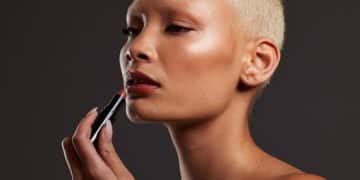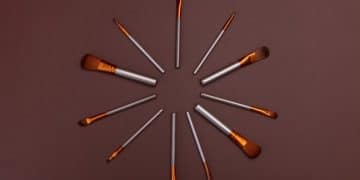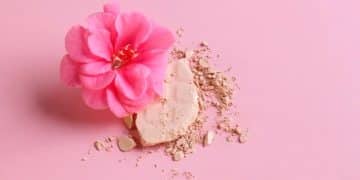Contour Like a Pro: Advanced Contouring Techniques for 2025
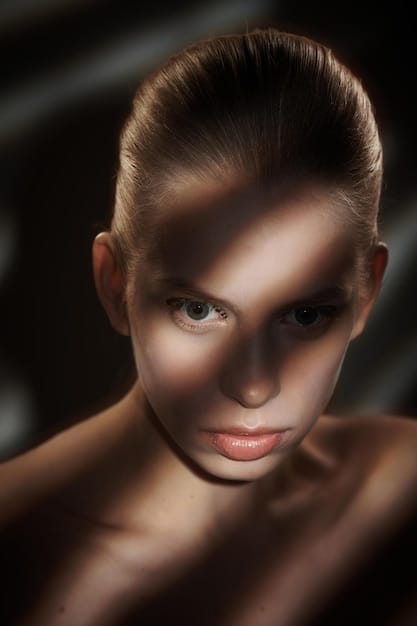
Achieving a professional facial sculpt with advanced contouring techniques in 2025 involves understanding sophisticated light and shadow interplay, leveraging innovative products, and adapting to personalized facial structures for enhanced definition and natural luminosity.
The art of facial sculpting has evolved dramatically, moving beyond simple shadow and light play to embrace nuanced techniques that celebrate individual beauty. In an era where makeup is both an art form and a personal statement, mastering Contour Like a Pro: Advanced Techniques for Sculpting Your Face in 2025 is essential for anyone aspiring to refine their look. This guide delves into the cutting-edge methods and insights that promise to elevate your contouring skills from basic to breathtakingly professional.
The Evolution of Contour: From Stage to Everyday Glamour
Contouring, once confined to the theatrical stage and professional photoshoots, has steadily migrated into the daily beauty routines of millions. Its initial purpose was stark: to dramatically redefine facial features under harsh lights. However, as techniques and products refined, contouring transformed into a subtle art, capable of enhancing natural bone structure without appearing heavy or artificial. The journey from thick, opaque sticks to finely milled powders and liquid formulations opened up new possibilities for everyday wear, emphasizing seamless blending and a more authentic, dimensional finish.
This evolution wasn’t accidental; it was driven by a deeper understanding of light, shadow, and color theory, combined with advancements in cosmetic chemistry. Early contouring was often about creating an illusion. Today, it’s more about revealing inherent beauty by strategically placing products that interact with light to create depth and lift. The shift in philosophy has also moved towards customization, acknowledging that no two faces are the same, and therefore, no single contouring method fits all. Personalized application, taking into account unique facial anatomy, has become paramount, leading to more sophisticated and flattering results for a diverse range of individuals.
Historical Foundations and Modern Adaptations
The roots of contouring can be traced back to the 16th century, where actors used chalk and soot to exaggerate facial expressions on stage. In Hollywood’s golden age, stars like Marlene Dietrich relied on skilled makeup artists to craft iconic looks using stage makeup. These early methods, though effective for their time, were far from subtle. The 1980s introduced a bolder, more angular approach, often characterized by sharp lines and pronounced contrast. However, it was truly the early 2000s, propelled by celebrity culture and then social media, that brought contouring into mainstream consciousness, popularized by figures demonstrating dramatic transformations.
Modern adaptations have softened these dramatic origins. Contemporary contouring emphasizes a “less is more” philosophy, focusing on diffused shadows and natural highlights that mimic the way light naturally falls on the face. This involves a thoughtful selection of shades that complement the skin’s undertone, rather than simply opting for universal cool-toned browns. The integration of skincare benefits into makeup products also means that today’s contour methods are not only aesthetically effective but also designed to be gentle and beneficial for the skin, avoiding the heavy, potentially pore-clogging formulas of the past.
- Soft Glamour: Focus on subtle enhancements rather than dramatic overhauls.
- Skin-Centric Formulas: Products now contain ingredients beneficial for skin health.
- Personalized Placement: Techniques adapted for diverse face shapes and features.
- Seamless Blending: The hallmark of professional contouring for a natural finish.
The trajectory of contouring continues to lean towards an approachable yet refined artistry. It’s about empowering individuals to understand and enhance their unique bone structure, ensuring that the finished look is harmonious and believable. The tools available have also diversified, with an array of brushes, sponges, and applicators designed for precision and effortless blending, making advanced techniques accessible to a broader audience. This constant evolution underscores contouring’s status not just as a trend, but as a fundamental skill in the modern beauty toolkit, consistently refining how we perceive and enhance facial dimensions.
Understanding Your Unique Face Shape: The Cornerstone of Advanced Contouring
Before diving into product application, a fundamental understanding of your own facial anatomy is crucial for achieving professional contouring results. Generic contouring guides, while helpful for beginners, often miss the mark when it comes to personalized enhancement. Every face tells a unique story, defined by its bone structure, muscle placement, and natural contours. Identifying your face shape—be it oval, round, square, heart, long, or diamond—serves as the blueprint for strategic product placement, ensuring that contouring genuinely enhances rather than distorts your features.
The beauty of advanced contouring lies in its adaptability. It isn’t about fitting a universal standard, but about highlighting your best features and creating visual balance where desired. For instance, someone with a round face might focus on creating more defined cheekbones and a nuanced jawline, whereas an individual with a long face might aim to minimize forehead height and add width. This highly individualized approach moves beyond simple product application, becoming an artistic endeavor rooted in personalized aesthetics. This personalization is what distinguishes amateur attempts from truly professional, flattering contouring.
Mapping Your Face for Precision
The process of mapping involves more than just identifying basic shapes; it requires observing how light naturally interacts with your face. Stand in front of a mirror in natural light and identify the areas where shadows naturally fall and where light hits and reflects. These natural lines and planes offer invaluable clues for where to apply contour and highlight. Understanding the interplay of light and shadow on your unique canvas allows for an organic, intuitive application that avoids harsh lines and creates a truly seamless blend.
Consider the nuances of your features: the width of your nose, the prominence of your cheekbones, the shape of your jawline, and the depth of your eye sockets. Each of these elements can be subtly enhanced or softened through precise contouring. For example, a slightly wider nose can be slimmed with two delicate lines of contour on the sides, blended inwards, while a lack of prominent cheekbones can be compensated by creating an illusion of depth just below them. This level of detail elevates contouring from a generic trend to a highly personalized art form, ensuring that the results are uniquely suited to your features and desired outcome.
- Observe Natural Shadows: Identify areas where shadows naturally occur on your face.
- Identify Light Reflection Points: Note where light naturally hits and creates highlights.
- Assess Facial Proportions: Understand the balance between forehead, cheekbones, and jaw.
- Consider Feature Specifics: Address the unique attributes of your nose, eyes, and mouth.
Ultimately, professional contouring in 2025 is less about following rigid rules and more about embracing a dynamic, analytical approach to your unique facial landscape. It’s an exploration of your features, identifying how to best leverage light and shadow to bring out your most flattering angles. This personalized methodology is not only more effective but also yields results that feel authentic and celebrate your individual beauty, making every application a deliberate and artful statement. The true mastery lies not just in applying products, but in understanding the canvas itself.
Advanced Product Selection for Seamless Contouring
The landscape of contouring products has vastly expanded, offering innovative formulas designed for both precision and natural blending. Moving beyond the traditional cream sticks and powders, 2025 sees an emphasis on hybrid formulas, skin-friendly ingredients, and an expanded shade range that caters to every skin tone and undertone. Advanced product selection isn’t just about choosing a dark brown; it’s about understanding how different textures and finishes interact with your skin and the overall makeup look you’re trying to achieve.
Professional contouring often involves a multi-product approach, layering different formulations for enhanced depth and longevity without looking heavy. For instance, beginning with a sheer liquid or cream contour for foundational definition, and then subtly layering a powder contour on top for added longevity and refinement, is a technique favored by many makeup artists. This layered approach ensures that the contour lasts throughout the day while maintaining a natural, skin-like finish, avoiding the dreaded “muddy” or artificial appearance that can result from improper product choice or application.
Texture, Finish, and Undertone Considerations
When selecting contour products, texture is paramount. Liquid and cream formulations offer a more dewy, skin-like finish, ideal for a natural look or for those with drier skin types. They blend seamlessly and can be applied with fingers, brushes, or sponges. Powders, on the other hand, provide a more matte finish and are excellent for setting cream products, adding intensity, or for individuals with oilier skin. The trend is moving towards finely milled powders that don’t settle into fine lines or appear cakey, offering buildable coverage for a customized level of definition.
The right undertone is perhaps the most critical factor often overlooked. Contour shades should mimic the natural shadows on your face, which are typically cool-toned. This means opting for shades with grey, taupe, or neutral undertones, rather than warm, orange-toned bronzers, which are intended to add warmth and color, not create shadow. Using a contour shade that is too warm can make your face appear dirty or striped, rather than sculpted. Testing shades in natural light on your jawline or neck will help determine the most flattering and realistic match, ensuring your contour looks like a natural shadow, not an applied product.
- Liquid/Cream Contours: Ideal for natural, dewy finishes and drier skin.
- Powder Contours: Perfect for setting, adding intensity, and oilier skin types.
- Cool Undertones: Crucial for mimicking natural shadows (grey, taupe, neutral).
- Hybrid Formulas: Combining benefits for versatility and longevity.
Furthermore, consider specialized products like contour wands for targeted application, or sheer, buildable contour drops that can be mixed with foundation for an all-over sculpted effect. The sheer variety means you can tailor your contouring arsenal to your specific needs and desired outcomes, whether you’re aiming for a subtle daytime sculpt or a more defined evening look. By investing in the right products and understanding their unique properties, you lay the groundwork for truly advanced and seamless contouring techniques that enhance your natural beauty with precision and artistry.
Mastering Precision Application Techniques
The difference between a subtle sculpt and a stark stripe often lies in the precision of application. Advanced contouring moves beyond simply drawing lines and instead focuses on strategic placement and meticulous blending. This requires not only understanding where the product goes but also how to apply it with the right tools and pressure, ensuring a natural, diffused effect. The goal is to create believable shadows that enhance bone structure, not obvious streaks of makeup.
One of the key tenets of professional application is subtlety. Begin with a minimal amount of product and build up intensity gradually. This approach allows for greater control and prevents over-application, which can be challenging to correct. Think of contouring as painting with light and shadow, where each stroke contributes to the overall dimension and harmony of the face. This careful, layered application is what gives contouring its sophisticated, seamless finish, making it appear as if your face is naturally sculpted, rather than artificially enhanced.
Tools, Strokes, and Blending Strategies
The right tools are indispensable for precision. For creamy or liquid contours, small, dense brushes or beauty sponges are ideal for pressing and blending the product into the skin. When using powders, fluffy, angled brushes allow for soft, diffused application, ensuring broad strokes rather than harsh lines. The direction of your strokes also matters: always apply contour in an upward motion towards the hairline or temples, mimicking the natural upward sweep of facial features. This lifting effect helps to make the face appear more chiseled and defined.
Blending is arguably the most critical step, transforming distinct lines into seamless shadows. After applying the product, use a clean, soft brush or sponge to gently diffuse the edges. Long, sweeping, circular motions work to melt the product into the skin, ensuring there are no harsh demarcation lines. For a truly professional finish, consider “baking” your contour: after applying cream and powder contour, lightly dust a translucent setting powder over the contoured areas to further soften, set, and prolong wear. This ensures the contour stays put and blends flawlessly into the rest of your makeup, creating an airbrushed effect that looks incredibly natural and polished.
- Use Dense Brushes/Sponges: For cream/liquid contour, press and blend.
- Opt for Fluffy Angled Brushes: For powder contour, ensure diffused application.
- Upward Blending Motions: Always blend towards the hairline or temples for a lifted look.
- Translucent Setting Powder: “Bake” contour for prolonged wear and seamless finish.
Ultimately, mastering precision application is about practice and patience. Experiment with different tools and techniques to find what works best for your face and the products you’re using. The goal is to achieve an undetectable contour that subtly enhances your features, creating depth and definition without looking “made up.” This refined approach to application is what truly elevates contouring to a professional level, making it an art form that complements and celebrates your natural beauty with remarkable subtlety and impact.
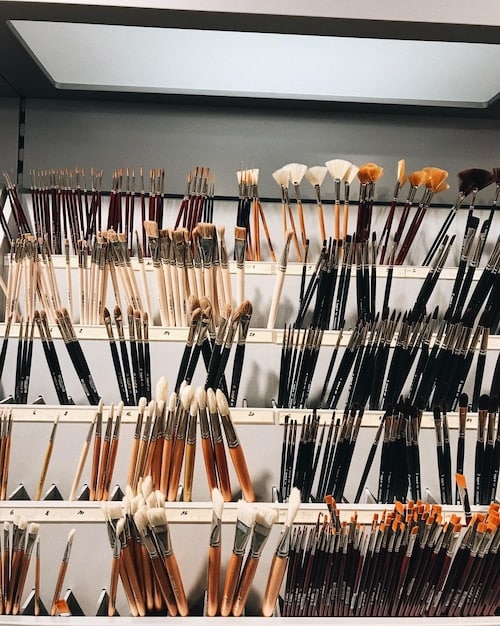
Beyond Basic Contouring: Advanced Techniques for Special Features
While the fundamentals of contouring focus on general facial sculpting, advanced techniques delve into the nuances of specific features, allowing for tailored enhancements that elevate the overall look. This specialized approach recognizes that each part of the face—from the nose to the lips—can benefit from targeted contouring, providing a level of precision that goes far beyond standard cheekbone and jawline definition. This is especially relevant for achieving harmonious balance and refining particular areas that might require subtle correction or enhanced emphasis.
Whether slimming a broader nose, enhancing the pout of lips, or subtly lifting an eye area, these advanced methods require a keen eye for detail and a delicate touch. The objective is not to drastically alter features but to create illusions of refinement and balance. By understanding how light and shadow can subtly reshape and define these specific areas, one can achieve a more cohesive and sophisticated sculpted look. This level of customization is what sets truly professional contouring apart, showcasing a mastery of detailed artistry.
Targeted Sculpting for Nose, Lips, and Eyes
Nose contouring is one of the most popular advanced techniques. To slim a broader nose, apply two fine lines of contour along the sides of the bridge, starting from the inner corner of the brows and extending down to the tip. Blend these lines gently inwards. For a shorter nose, apply a small dot of contour just beneath the tip to create an upward illusion. Conversely, to minimize a longer nose, place contour across the tip. The key here is not to create harsh lines, but soft, diffused shadows that subtly reshape without being obvious, using a small, precise brush for application.
Lip contouring, often overlooked, can dramatically enhance pout and shape. Apply a small amount of contour just below the center of the lower lip to create a subtle shadow, making the lip appear fuller. For upper lip definition, a tiny amount of highlight on the cupid’s bow can make the top lip appear more prominent. Eye contouring goes beyond eyeshadow; a very light contour in the crease can deepen the eye socket, making the eyes appear larger and more set. Similarly, a touch of highlight on the brow bone and inner corner can brighten and lift the entire eye area, creating a more awakened and polished look. These small, deliberate applications, when expertly blended, contribute significantly to the overall sculpted effect, proving that true artistry lies in the details.
- Nose Contouring: Fine lines for slimming, dots for shortening or minimizing.
- Lip Contouring: Subtle shadow for fullness, highlight on cupid’s bow for definition.
- Eye Contouring: Light contour in crease for depth, highlight on brow bone/inner corner for brightening.
- Precise Tools: Utilize small, delicate brushes for targeted application.
Mastering these advanced, feature-specific techniques adds another dimension to your contouring repertoire. They enable you to address individual concerns or desires with precision, ensuring that every aspect of your facial structure is harmoniously balanced and beautifully enhanced. This bespoke approach to contouring ensures that the final result is not only visually striking but also uniquely tailored to your individual features, reflecting a truly professional level of artistry and attention to detail.
Maintaining Your Sculpt: Setting and Longevity Tips
Achieving a perfectly sculpted face is only half the battle; ensuring it lasts throughout the day (or night) is equally crucial for professional results. No matter how meticulously you apply your contour, without proper setting and longevity techniques, it’s susceptible to melting, fading, or creasing. Advanced contouring extends beyond initial application to encompass strategies that lock your masterpiece in place, standing up to humidity, activity, and the passage of time. This focus on durability is what truly elevates a temporary artistic statement into a lasting impression.
The goal is to preserve the integrity of your sculpted features from morning to night, maintaining the precision and definition you painstakingly created. This involves a strategic layering of products and the intelligent use of setting agents that not only prolong wear but also contribute to the overall seamless finish. Avoiding common pitfalls like over-powdering or using incompatible product textures will contribute significantly to the longevity and freshness of your contoured look.
Layering, Setting Sprays, and Touch-up Strategies
Layering is a cornerstone of long-lasting contour. If you’re using a cream or liquid contour, always set it with a corresponding powder contour in a similar cool-toned shade. This “powder over cream” technique creates a durable base, enhancing both the intensity and tenacity of the contour. Ensure the powder is finely milled and applied sparingly to prevent a cakey appearance. The principle is to create a multi-dimensional effect that is inherently more resistant to breakdown due to skin oils or environmental factors.

Following this, a high-quality setting spray is indispensable. Mist your face evenly after all makeup application, holding the bottle at arm’s length. Modern setting sprays go beyond merely holding makeup; many contain hydrating, mattifying, or skin-balancing ingredients that can actively improve the look and feel of your contoured skin. They help to meld all the layers of makeup together, creating a more skin-like, less powdery finish, effectively “locking” your contour in place without stiffness. For targeted longevity in specific areas like the T-zone or under the eyes, consider using a translucent setting powder, lightly pressed onto the skin with a damp beauty sponge or powder puff, then allowed to “bake” for a few minutes before brushing off the excess.
- Cream-to-Powder Setting: Layer cream/liquid contour with a powder contour.
- Quality Setting Spray: Lock in makeup with an even mist, enhancing finish and wear.
- Targeted Powder Baking: Use translucent powder on oily zones for extra durability.
- Minimal Touch-ups: Focus on blotting excess oil rather than reapplying product.
For touch-ups throughout the day, resist the urge to reapply more contour product immediately. Instead, use blotting papers to absorb any excess oil without disturbing your makeup. If a reapplication is truly necessary, use a very light hand with a small amount of powder contour on a fluffy brush. This helps refresh the sculpt without adding unnecessary bulk or creating a muddy appearance. By adopting these advanced setting and longevity strategies, your professional contour will maintain its impeccable definition and seamless blend from the moment you apply it until you’re ready to remove it, ensuring your artistic efforts are preserved beautifully.
Common Contouring Mistakes and How to Avoid Them
Even with the most sophisticated techniques, common mistakes can derail a flawless contour. Recognizing and proactively avoiding these pitfalls is a hallmark of truly professional application. Often, these errors stem from a lack of understanding of product, tools, or fundamental principles of light and shadow. The goal of advanced contouring is to create a seamless, natural-looking sculpt, and knowing what to avoid is as crucial as knowing what to do. Many common issues lead to an artificial or overdone appearance, counteracting the very purpose of enhancing natural features.
From choosing the wrong shade to improper blending, these missteps can make contouring look heavy, muddy, or even unflattering. By being aware of these common errors, you can refine your technique, ensuring that your efforts consistently result in a polished and sophisticated finish. This proactive approach to error prevention is key for anyone aiming to master the art of professional facial sculpting, transforming potential frustrations into opportunities for perfection.
Avoiding the Dreaded “Muddy” or “Striped” Look
One of the most frequent mistakes is using a contour shade that is too warm or too dark. Warm, orange-toned shades act as bronzers, adding color rather than creating the illusion of shadow, which should be cool-toned (greyish-brown). Using a shade that is too dark for your skin tone, or applying too much product, leads to a “muddy” appearance, making your face look dirty instead of sculpted. Always opt for a contour shade that is only 1-2 shades darker than your natural skin tone and has a cool or neutral undertone, ensuring it mimics genuine shadows.
Another common pitfall is improper blending, resulting in visible “stripes” on the face. Harsh, unblended lines immediately give away that you’re wearing contour, ruining the illusion of natural definition. To avoid this, dedicate adequate time to blending, using clean brushes or sponges, and ensuring all edges are diffused seamlessly into your foundation. Over-applying product in one go, without building up layers, also contributes to a striped effect. Start with a tiny amount and gradually build up intensity. Moreover, applying contour to the wrong areas of the face or using an incorrect technique for your face shape can lead to an unnatural or unbalanced look. Always refer back to a personalized face map and natural shadow lines to guide your application, ensuring every stroke contributes positively to your desired facial structure. By meticulously avoiding these common mistakes, your contour will consistently appear polished, natural, and truly professional.
- Avoid Warm/Dark Shades: Choose cool or neutral contour 1-2 shades darker than skin.
- Prioritize Blending: Ensure all lines are seamlessly diffused into the skin.
- Build Up Product Gradually: Start with minimal product; layer for intensity.
- Follow Face Map: Apply contour according to your unique facial structure and natural shadows.
Ultimately, becoming proficient in advanced contouring is as much about refinement and rectification as it is about initial application. Recognizing these prevalent errors and implementing corrective measures or preventive strategies ensures that your sculpted look remains sophisticated and natural. It solidifies your ability to navigate the intricacies of makeup artistry with precision, enabling you to consistently achieve a polished, professional finish that enhances your natural beauty effectively and seamlessly.
| Key Contour Principle | Brief Description |
|---|---|
| ✨ Face Mapping | Understanding your unique bone structure is crucial for personalized, effective contour placement. |
| 🎨 Product Selection | Choose cool-toned, buildable formulas that complement your skin type for natural shadows. |
| 🖌️ Precision/Blending | Apply sparingly with appropriate tools, ensuring seamless, diffused edges for a natural finish. |
| ⏳ Longevity Tactics | Layer cream with powder and use setting sprays to ensure your sculpt lasts all day. |
Frequently Asked Questions About Advanced Contouring
▼
Contour creates artificial shadows to sculpt features, typically with cool, grey-toned shades. Bronzer adds warmth and a sun-kissed glow to the face, usually in warm, orange or golden tones. While both add dimension, their purposes and undertones differ significantly for professional results.
▼
Absolutely, layering cream contour with a powder contour is an advanced technique for enhanced longevity and depth. Apply the cream first for initial definition, then lightly set or intensify with a powder version for a more durable and refined sculpted look. This also aids seamless blending.
▼
Choose a contour shade that is only one to two shades darker than your natural skin tone and, crucially, has a cool or neutral undertone. Avoid warm, orange-based bronzers. Test the shade on your jawline or neck in natural light to ensure it creates a realistic, natural-looking shadow.
▼
For cream/liquid contours, a dense angled brush or a damp beauty sponge is ideal for precise application and seamless blending. For powder contours, a soft, fluffy angled brush or a fluffy tapered brush allows for diffused application. Small, precise brushes are vital for feature-specific contouring like the nose.
▼
To avoid a muddy look, ensure you’re using a cool-toned contour shade that’s not too dark. Apply product sparingly, building intensity in thin layers. Most importantly, blend thoroughly until no harsh lines are visible. A light touch and proper blending are key for a natural, refined finish.
Conclusion
Mastering advanced contouring techniques in 2025 is an intricate yet incredibly rewarding journey into the art of facial sculpting. It transcends basic application, demanding a deeper understanding of your unique facial structure, intelligent product selection, and precise application with meticulous blending. By embracing these sophisticated methods, you gain the power to enhance your natural beauty, create remarkable depth, and achieve a truly professional, personalized look that feels both authentic and breathtaking. The evolution of contouring underscores its significance in modern beauty, transforming it from a mere trend into an indispensable skill for anyone aspiring to refine their aesthetic with unparalleled precision and artistry.
